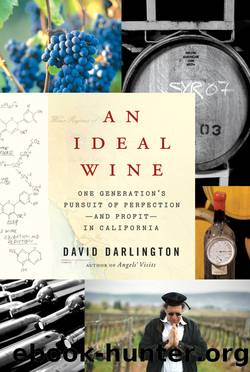An Ideal Wine by David Darlington

Author:David Darlington
Language: eng
Format: epub
Publisher: HarperCollins
Published: 2011-06-30T16:00:00+00:00
Chapter 19
After Felton Empire folded in the late 1980s, Leo McCloskey returned to Ridge as a part-time consultant. In the decade since he’d discovered the work of T. C. Somers and gone back to school, a number of things had changed; the number of California wineries had doubled to more than 800, and U.S. table wine consumption had risen commensurately, from 262 million gallons in 1977 to 481 million in 1986. On the other hand, the stock market rise of the mid-Reagan years had been followed by the correction that helped sink Felton Empire. Amid this ever more crowded, increasingly nervous market, critics were acquiring a more prominent role on behalf of consumers. The rise of Robert M. Parker Jr. and the Wine Advocate was paralleled by that of the Wine Spectator, a former San Diego newsprint tabloid that, after being purchased by investment banker Marvin Shanken in 1979, became a glossy luxury-lifestyle magazine promoting not only wine but also dining and travel. As part of this transformation, the Spectator implemented tasting-evaluation panels, beginning with UC Davis’s 20-point system, but adopting the 100-point scale by the mid-1980s.
In other words, McCloskey says, “Critics were starting to control the value chain” that went from the winery to the distributor to the retailer and restaurateur to the consumer. “In the old British evaluation system, wine writers were closely linked to the industry,” he points out. “They promoted the idea that everything about wine was a mystery—it was salesmanship. Even Amerine’s book on sensory analysis said that quality isn’t real; it’s about defect testing, and it promotes the use of words like character or texture to describe attributes. Quality ratings and scores and classifications were anathema to modern sensory analysis; in the seventies, if a winemaker screwed up and made an average or below-average wine, he just said, ‘Too bad—deal with it. I’m Picasso.’ So by 1990 everybody was discrediting the score, but I saw that the critics were going to win because Americans wanted to reduce their risk of purchase and winemakers weren’t filling the information void.” Harking back to the “detectable ecotypic expression” he’d studied in chemical ecology, McCloskey concluded that “Parker and the Spectator are like scouts for the tribe—they go out and tell the others whether it’s safe to eat the stuff.”
At Ridge Leo helped, among other things, to get the winery’s pesky Brettanomyces problem under control by filtering rather than following the low-tech regimen with which the place identified itself. It’s safe to say that, after fifteen years of association, McCloskey and winemaker Paul Draper maintained a testy relationship, as McCloskey constantly challenged Draper’s Old World philosophy with his upstart activist ideas. In retrospect, Draper credits McCloskey mainly for presenting an alternative viewpoint to his own—for suggesting, for example, when Ridge separated cabernet grapes from their skins at harvest, that it analyze tannin in progressively tighter pressings of the fruit, rather than combining all of it in one big lot. This resulted in a more finely blended product and, ultimately, more individualistic treatment of each vintage.
Download
This site does not store any files on its server. We only index and link to content provided by other sites. Please contact the content providers to delete copyright contents if any and email us, we'll remove relevant links or contents immediately.
Whiskies (Collins Gem) by dominic roskrow(42215)
101 Whiskies to Try Before You Die by Ian Buxton(42183)
Whiskies Galore by Ian Buxton(40334)
Craft Beer for the Homebrewer by Michael Agnew(17447)
Right Here, Right Now by Georgia Beers(3497)
Not a Diet Book by James Smith(2726)
Water by Ian Miller(2584)
The Coffee Dictionary by Maxwell Colonna-Dashwood(2531)
Kitchen confidential by Anthony Bourdain(2306)
Coffee for One by KJ Fallon(2008)
Smuggler's Cove: Exotic Cocktails, Rum, and the Cult of Tiki by Martin Cate & Rebecca Cate(1980)
Beer is proof God loves us by Charles W. Bamforth(1921)
Superfood Smoothie Bowls: Delicious, Satisfying, Protein-Packed Blends that Boost Energy and Burn Fat by Chace Daniella(1904)
Talking as Fast as I Can by Lauren Graham(1832)
Bourbon: A Savor the South Cookbook by Kathleen Purvis(1791)
A Short History of Drunkenness by Forsyth Mark(1720)
Eat With Intention by Cassandra Bodzak(1688)
Cocktails for the Holidays by Editors of Imbibe magazine(1626)
Colombia Travel Guide by Lonely Planet(1611)
